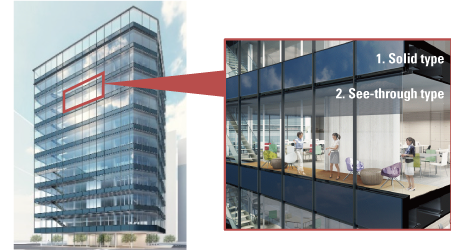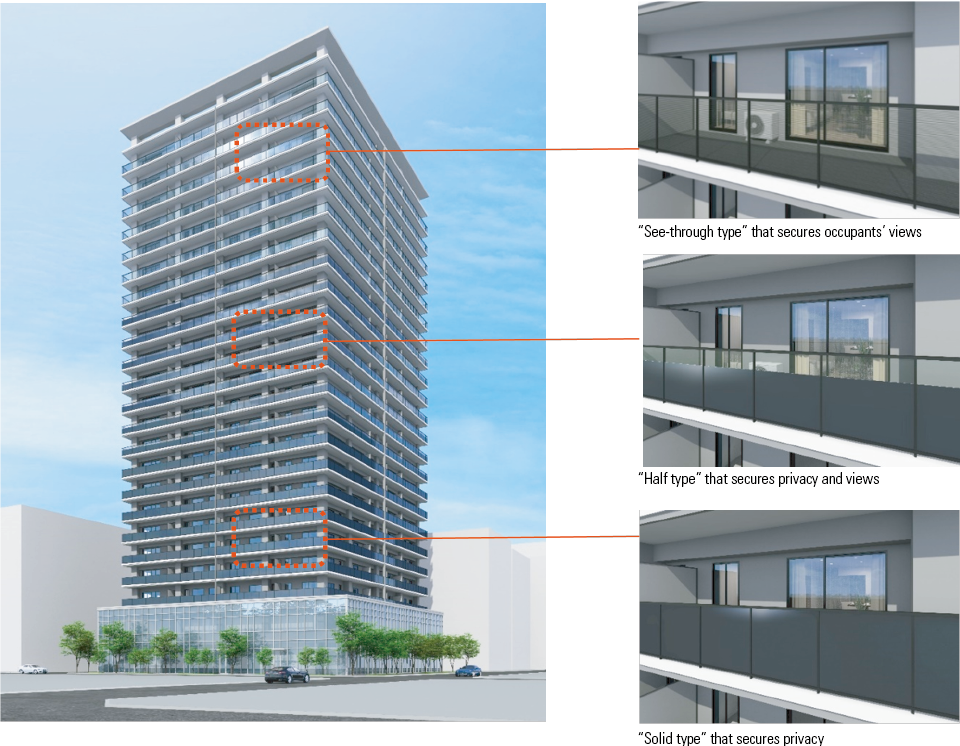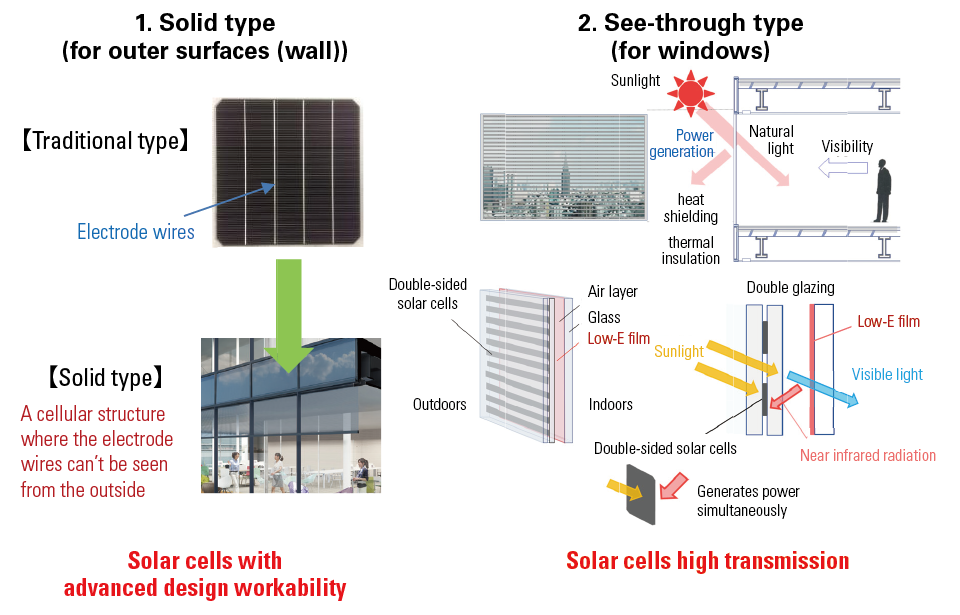November 2022
- English
- 日本語
Development of Glass that Generates Energy from Sunlight

A conceptual image of T-Green Multi Solar

A Japanese chemical manufacturer and construction company have jointly developed “photovoltaic power generation glass” that can be installed on the external walls and windows of buildings.
Amidst progress with measures to combat climate change in the global society, the Japanese government announced a goal of achieving “carbon neutrality” with zero carbon for all greenhouse gas emissions by 2050. Currently, companies in various fields are accelerating their initiatives and the development of new products aimed at achieving carbon neutrality.
One technology that will contribute to achieving carbon neutrality is solar power generation. In recent years, as solar power has spread within Japan, the amount of energy produced through solar power is on the rise. On the other hand, it is necessary to secure a certain amount of space to install the equipment and photovoltaic cell modules (solar panels) needed for solar power generation. In reality, in urban areas with many buildings and business districts in particular, the only spaces with plenty of sunlight are building rooftops, and space saving has become a major issue. Meanwhile, in 2019, Kaneka Corporation, a synthetic chemical manufacturer, and Taisei Corporation, a general contractor, jointly developed “T-Green Multi Solar,” a photovoltaic power generation glass that can be installed on external walls and windows.
Kaneka began basic research on photovoltaic cells in the 1980s and developed a variety of photovoltaic cells, including thin film silicon solar cells coated with extremely thin silicon-film on glass and cells that are integrated into roof tiles. Taisei built a “ZEB (Zero Energy Building) demonstration building” in 2014 within their own technology center and achieved net zero energy for the entire building through energy-saving technologies and solar power. Taisei has come to lead the construction field with energy saving and energy creation.
Kaneka’s Nakajima Akihiko says, “The times demand carbon neutrality, and this led to the joint development of photovoltaic power generation glass that goes beyond the achievements or problems of either of our companies.” Taisei’s Satori Noritaka says, “As we have promoted carbon neutrality in the construction field, we felt that it was important to work together with a company that was developing advanced photovoltaic cell technology.”
Satori explains the features of T-Green Multi Solar as follows.
“There is limited space on rooftops in urban areas, but this product can be installed in a wide range of places such as windows or as cladding on external walls. Another important point is that the glass can produce energy over a long period of time, not just when the sunlight is strong, but with the morning sun in the east and the evening sun in the west. As the photovoltaic cells are integrated into the cladding, it is easy to install and features the same durability as ordinary cladding. It can also function as an independent emergency power source in times of disasters.”
T-Green Multi Solar comes in two varieties: a “solid type,” where the photovoltaic cells can be used as is as wall-mounted type external panels, and a “see-through type,” where 4-mm-wide photovoltaic cells, which can produce energy on both sides, are sandwiched in a striped pattern on double-glazed glass. The former can be installed in external walls and the latter turns glass into power generation equipment (see images). The see-through type was made so that in addition to direct sunlight, infrared rays and other light reflected by the glass coated with Low-E* film on the interior side passes through the spaces between the photovoltaic cells. Making use of the structure sandwiching the cells between glass, light that would normally be reflected outward is captured and used to create energy, and this is another major advantage. The see-through type was highly praised for both its power generation efficiency and its design, and was awarded the Good Design Award in 2021. It was also selected as a model project related to renewable energy promoted by the Tokyo Metropolitan Government in 2022. T-Green Multi Solar will be installed in turn at the Tokyo International Exhibition Center (Tokyo Big Sight) and other public facilities in Tokyo.
Using the see-through type as a power source can produce enough power to charge about nine smartphones a day for each square meter, though this varies based on installation conditions.
At the beginning of October this year (2022), a model of “T-Green Multi Solar” for balconies was developed and announced. It is a power generation system that can be installed on balconies of detached homes and apartment buildings, with T-Green Multi Solar being installed on the balcony handrailing. The new half-type (Half type), which combines the conventional solid type and see-through type, was designed to block the view from below the balcony but ensure a view from within the room (see images).
The two companies plan to expand overseas. Nakajima says, “We hope to expand our business while boosting local employment and making use of the architectural glass technology of each country. The photovoltaic cells will be manufactured in Japan and the glass will be manufactured with cooperation from local partners. I hope that we can spread our photovoltaic power generation glass to many countries.”
Advanced glass developed in Japan may come to change the windows and walls of the world.


* Low-E film is a metallic film that, when used to coat glass, increases thermal heat solar shading performance

